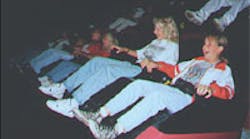During a blistering hot day at the theme park, that air-conditioned theater looks like a great place to sit down and relax. But when the lights dim, you feel yourself suddenly catapulted into a stock car racing at 200 mph around the track at Daytona International Speedway. You experience every bump, turn, and collision as realistically as a driver during the race. Actually, you are enjoying motion simulator theater, the latest rage in location-based entertainment.
Motion simulator theaters have become a prime ingredient for many theme park rides and attractions around the world. These theaters provide chills and thrills — without physical jeopardy — through the motion of computer- controlled, hydraulically actuated seats, synchronized with high-resolution video action on a screen and multi-channel audio broadcasts. The mind combines these motion, sight, and sound clues — through the virtual reality concept — to provide perceived adventures limited only by the imagination of the simulator theater creators.
Theme parks apply motion simulators to spectacular rides such as Days of Thunder at Paramount, Back to the Future . . . The Ride at Universal Studios, and Star Tours at Disney. But you no longer have to visit a theme park to enjoy a simulator theater; you now can find them in casinos, shopping malls, museums, fairs, exhibits, and even on the fringes of events such as air shows and car races.
One of the most successful simulator theater manufacturers is Iwerks Attractions and Technologies, Burbank, Calif. Iwerks has been building their Turbo Ride simulator theaters worldwide since 1986. Typical installations range from six to 80 simulators and provide seating for 12 to 160 passengers. Only the physical size of the theater limits the number of seats. Iwerks also builds a portable simulator theater called The Reactor. Reactors are 18- passenger theaters built into two tractor trailer rigs that travel to show sites.
Smooth, reliable motion, high power density, and wide frequency response all contribute to making hydraulics the medium of choice for simulator designers. Hydraulics can faithfully reproduce movements ranging from docile, ultra-smooth hot air balloon rides to screaming jet fighters and even futuristic time and space warps. Hydraulic servo and proportional technology generates these moving experiences (in and out of body) and much more.
The broad performance bandwidth of hydraulics provides consistent realism and versatility. A show with relatively smooth motions — the hot air balloon ride, for example — can be converted to a radical roller coaster in a matter of minutes. The conversion requires only software and video changes. Because of the frequency response of the electrohydraulic valves, no additional tuning or adjustment is required. This can save significant setup time and ensure uniform performance from base to base, theater to theater.
The Iwerks Turbo Ride motion base is a compact, self-contained, two-seat hydraulic motion simulator supplied by Vickers, Inc., Troy, Mich. Its 3-degreeof- freedom design is used in both permanent and portable installations. The modular design negates the need for large, central power units and their associated pressure and return line headers even in large theaters. Installation of the modular units simply requires bolting down the base and plugging in the electrical connectors. This minimizes space requirements, while reducing setup time and expense, and the number of potential leak points.
To supply three TJ linear actuators, each motion base contains a complete hydraulic power unit: reservoir, accumulator, pump, electric motor, filter, and manifold assembly. The manifold assembly mounts the Vickers electrohydraulic and cartridge valves. Each actuator has a linear transducer from Penny and Giles, Attleboro, Mass., to feed position back electrically.
To minimize the possibility of leaks further, Iwerks chose Aeroquip ORS-type O-ringseal hose and tube fittings, similar to those used in the aerospace industry. All other hydraulic connections are made via SAE-type fittings. These connectors have proven their reliability in theaters logging hundreds of thousands of shows.
Iwerks engineers also designed the closed-loop control system and valve drivers. In operation, computers receive signals imbedded in the video and then sequence moves for each axis at the appropriate time. Computers also continuously monitor sensors in the seats for occupant and seat belt status.
Electrohydraulic motion bases have a bright, liability-free future in the entertainment industry. They allow producers to build new levels of realism, fantasy, and excitement into their shows. Continued technical advances will blur the line between illusion and reality even further.
So if you ever need a reality check, a simulator theater is not the place to go. The experience may leave you more confused than ever! If, however, your goal is cutting-edge entertainment, visit one of these simulator theaters and enjoy the latest in imagination, creativity . . . and hydraulic technology.
John Kostyal, with Vickers, Inc., Pacifica, Calif., submitted this report.


